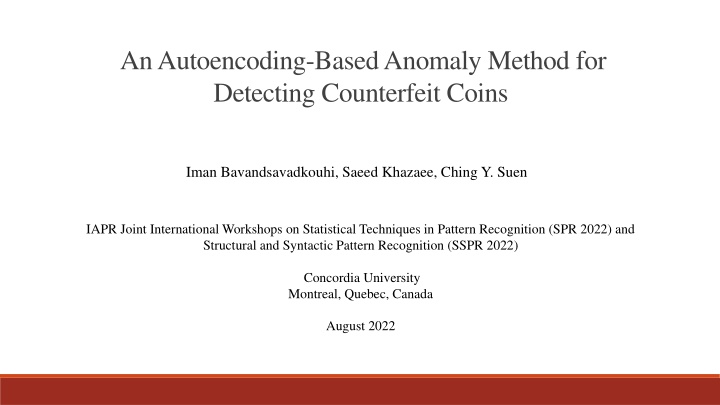
Autoencoding-Based Anomaly Detection for Counterfeit Coins
Explore an innovative autoencoding-based method for detecting counterfeit coins using similarity criteria and reconstructing genuine coin features. Learn how this technology can combat the rise of fake coin production in the market.
Download Presentation

Please find below an Image/Link to download the presentation.
The content on the website is provided AS IS for your information and personal use only. It may not be sold, licensed, or shared on other websites without obtaining consent from the author. If you encounter any issues during the download, it is possible that the publisher has removed the file from their server.
You are allowed to download the files provided on this website for personal or commercial use, subject to the condition that they are used lawfully. All files are the property of their respective owners.
The content on the website is provided AS IS for your information and personal use only. It may not be sold, licensed, or shared on other websites without obtaining consent from the author.
E N D
Presentation Transcript
An Autoencoding-Based Anomaly Method for Detecting Counterfeit Coins Iman Bavandsavadkouhi, Saeed Khazaee, Ching Y. Suen IAPR Joint International Workshops on Statistical Techniques in Pattern Recognition (SPR 2022) and Structural and Syntactic Pattern Recognition (SSPR 2022) Concordia University Montreal, Quebec, Canada August 2022
Outline: Introduction Dataset Proposed method overview Selecting similarity criterion Autoencoding-Based Counterfeit Coin Detection Result Conclusion
Introduction Imaged Based Counterfeit Coin Detection? Detecting a fake coin with very high quality. The system should recognize each feature of the coin's surface precisely. Why is it Important? CBC News reported on the existence of counterfeit coins in January 2022. Every year, billions of dollars are traded in the buying and selling of valuable coins. A lot of illegal producers have counterfeited valuable coins by using high technology techniques. 1
Dataset CENPARMI Danish coin dataset that all of the coins have been scanned by the 3-D scanner in previous studies. Genuine Fake 2
Proposed method overview Calculating the similarity (Using SIFT) Detection of counterfeit coin Reconstructing the genuine coin Training the Autoencoder 3
Why we choose SIFT? In this section, we investigate image similarity using certain well-known feature extraction descriptors such as, MSER, SURF and SIFT. Number of pair of images MSER SURF SIFT 1 0.065028 0.479243 0.461538 2 0.043478 0.495652 0.205128 3 0.133647 0.391080 0.435897 4 0.083612 0.530473 0.358974 299 0.103448 0.381191 0.615384 300 0.080645 0.702909 0.666666 4
Autoencoding-Based Counterfeit Coin Detection Training The Autoencoder: For training the model, our trainset contains only genuine coins, and we keep the fake samples to test the model. Autoencoder 5
How to detect the counterfeit coin? Degree of resemblance by SIFT Reconstruct Autoencoder 0.98 Degree of resemblance by SIFT Reconstruct 0.78 Autoencoder 6
Genuine Input Counterfeit Input Counterfeit Output Genuine Output Danish 1990 Danish 1991 Danish 1996 7
Experimental Results Average of similarity for the generated coin image by autoencoder with the selected basic coin image for both genuine and counterfeit coin image as input. Genuine Counterfeit Dataset Similarity by SIFT Dataset Similarity by SIFT Danish 1990 0.98 Danish 1990 0.73 Danish 1991 0.97 Danish 1991 0.81 Danish 1996 0.93 Danish 1996 0.60 Danish 2008 0.96 Danish 2008 0.78 8
Conclusion We proposed a method to detect counterfeit coins using anomaly detection approaches. We proposed a method that eliminates the dependency on fake data for the training. Our method is capable of detecting counterfeit Danish coins with 98.0 %, 97.1%, 99.7%, and 99.6% accuracy for Danish 1990, Danish 1991, Danish 1996, and Danish 2008 respectively. 9

